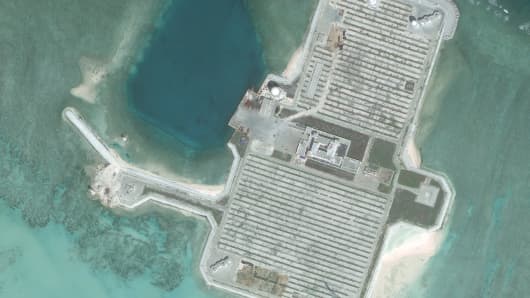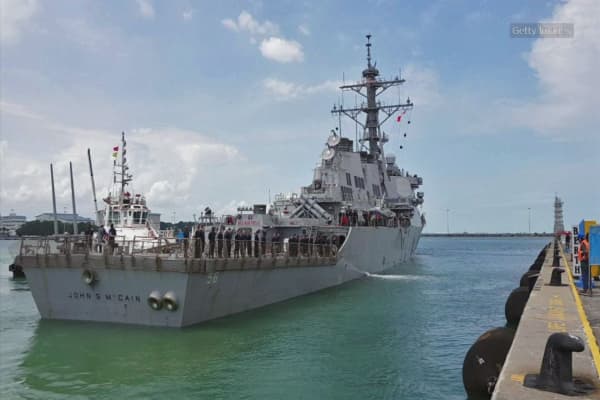Golez: China will be no. 1 loser: "If a crisis slams the South China Sea, here are the losers — and a few winners" https://t.co/AcqLsY3NPY
I quote from this CNBC article:
1. "Several industries are trying to assess what open confrontation in the South China Sea would cost them, and a lot of them don't like what they're finding.
2. China the most nervous: "(China)The world's second-largest economy is getting more wary — and more vocal in its opposition — about increased U.S. naval patrols along the vast body of water, which holds some of the world's busiest trade routes."
3. Most of the seaborne trade are China connected: "With more than $5 trillion of trade flowing through the area every year, any hostility between would hit numerous business sectors, including commodities, logistics, and insurance.
"Conflict between the U.S. and China in the South China Sea would be less about the physical things that can be produced, but more about controlling physical access and the key choke-points around it," Stratfor analyst Matthew Bey told CNBC earlier this year.
4. "Almost every major container shipping company sends vessels through the South China Sea, making all of them vulnerable if Washington and Beijing butt heads, said Bey. "The ports that would be adversely impacted are the Straits of Malacca, East China straits, straits of Sunda and Lombok."
5. It will choke China's oil trade. At least 70% of China's oil passes through the South China Sea: "Should Trump increase patrols by China's artificial islands as part of his new policy, that could particularly hurt the China National Offshore Oil, one of the the mainland's biggest crude producers, Bey added.
Also known as CNOOC, the firm has commercial drilling platforms in the South China Sea and drew international attention in 2014 after placing an oil rig near the Paracel Islands that triggered a major spat between Beijing and Hanoi.
CNOOC offered no comment on the matter.
6. Maritime insurance would spiral: "Paying a premium for protection
Maritime insurance rates may spike if insurers identify parts of the South China Sea as a war risk.
7. Ships might even avoid the area completely and strangle China's trade: "That means vessels would have to pay a premium to transit the area — or avoid the area completely, explained Andrew Booker, founding partner of marine specialist Latitude Brokers. However, that scenario remains highly unlikely at present, he added.
"It's impossible to estimate how high rates could rise but because there is no premium for transiting the area at present, anything would be an increase, he said.
"If that were the case, trade routes would change and freight costs for each voyage would rise, which could be good news for ship-owners but bad for charterers who pay freight, Booker continued.
8. "Currencies will depreciate
"Geopolitical strains could also weaken the Korean won and the Taiwan dollar.
"Financial markets in those countries have a large number of foreign equity investors, and those traders tend to sell shares in the wake of political tensions, explained Khoon Goh, head of Asia research at Australian bank ANZ.
"When those stock markets take a beating, so do their currencies. If that's the case, Goh predicts the won will fall to 1180 per dollar from 1130 presently, and the Taiwan dollar to hit 31.6 from current levels of 30.2.
9. Will benefit the yen: "But the safe-haven Japanese yen would likely benefit amid the overall risk-averse mood, Goh added.
10. Oil prices will spiral: "Oil climbs
"The South China Sea holds around seven billion barrels of oil and 900 trillion cubic feet of natural gas, but in the event of hostilities, those reserves won't be first in the firing line.
"The more immediate impact may be a rally in global crude prices. Any conflict could disrupt the movement of energy resources, thus curbing overall supply and pushing Brent crude to around $65 per barrel, said Jonathan Chan, investment analyst at Phillip Futures. Oil futures trade hands at about $52 currently.
11. "Air freight is considerably more expensive than maritime shipping, and even within countries, overland networks are often not as well-developed. Maritime routes remain the most popular for the transportation of resources, he said.
12. "Metals and minerals to bounce
China to be badly affected if metal prices go up: "Beijing imports massive quantities of copperand iron ore, so any blockage or disturbance to transport routes would cause prices of both commodities to spike, according to Chan.
"Iron ore on the SGX Asia Clear could hit $95 per metric ton in the event of escalation," Chan said, "while copper may soar to $6,480 per ton."
Gold, may rally to $1,450 per ounce, Chan added. That would mark a sharp bounce from its present level of near $1,285.
13. "Happier fish and fishermen
"An estimated 12 percent of the world's fish harvest comes from the South China Sea, where more than 3,000 known species dwell. But fish stocks have been rapidly declining amid Beijing's island-building activities.
"If Washington can stop Chinese construction and protect the rights of regional fishermen — especially Vietnamese, Indonesians and Filipinos — that would be welcomed, said Greg Poling, director of the Asia Maritime Transparency Initiative, at the Center for Strategic and International Studies.
"The sand and silt plumes created by dredging sand and gravel can kill fish or drive them from the reefs — a major problem for Southeast Asian fishermen who rely on the creatures for their livelihood.
"The problem is further exacerbated by China's annual fishing ban, typically between mid-May to early August, in parts of the sea that it administers. "Chinese dominance has been bad news for Southeast Asian fishermen, as evidenced by the way the Chinese authorities treat Vietnamese fishermen during the 3-month ban," Poling said.
Several industries are trying to assess what open confrontation in the
South China Sea would cost them, and a lot of them don't like what they're finding.
The world's second-largest economy is getting more wary — and more vocal in its opposition — about increased U.S. naval patrols along the vast body of water, which holds some of the world's busiest trade routes.
The U.S. Navy has sailed close to South China Sea reefs, atolls and other areas claimed by Beijing several times in recent months, under the pretext of freedom of navigation operations. In late May,
the USS Dewey sailed within 12 miles of the Chinese artificial island Mischief Reef. In July, the USS Stethem passed by the Chinese-administered Triton Island. Then last week, the
USS John S. McCain traveled close to Mischief Reef.

Sean M. Castellano | US Navy | Reuters
A U.S. Navy MH-60R Sea Hawk helicopter from the "Blue Hawks" of Helicopter Maritime Strike Squadron 78 fires chaff flares during a training exercise near the aircraft carrier USS Carl Vinson (CVN 70) in the Philippine Sea April 24, 2017.
Watch out for these companies
With more than
$5 trillion of trade flowing through the area every year, any hostility between would hit numerous business sectors, including commodities, logistics, and insurance.
"Conflict between the U.S. and China in the South China Sea would be less about the physical things that can be produced, but more about controlling physical access and the key choke-points around it," Stratfor analyst Matthew Bey told CNBC earlier this year.

USGS/NASA Landsat data/Orbital Horizon/Gallo Images/Getty Images
Satellite image of the Scarborough Shoal in the South China Sea, a fishing-rich area claimed by both Manila and Beijing, on 12 January 2017.
Almost every major container shipping company sends vessels through the South China Sea, making all of them vulnerable if Washington and Beijing butt heads, said Bey. "The ports that would be adversely impacted are the Straits of Malacca, East China straits, straits of Sunda and Lombok."
Should Trump increase patrols by China's artificial islands as part of his new policy, that could particularly hurt the
China National Offshore Oil, one of the the mainland's biggest crude producers, Bey added.
Also known as CNOOC, the firm has commercial drilling platforms in the South China Sea and drew international attention in 2014 after placing an oil rig near the Paracel Islands that triggered
a major spat between Beijing and Hanoi.
CNOOC offered no comment on the matter.
Paying a premium for protection
Maritime insurance rates may spike if insurers identify parts of the South China Sea as a war risk.
That means vessels would have to pay a premium to transit the area — or avoid the area completely, explained Andrew Booker, founding partner of marine specialist Latitude Brokers. However, that scenario remains highly unlikely at present, he added.
It's impossible to estimate how high rates could rise but because there is no premium for transiting the area at present, anything would be an increase, he said.
If that were the case, trade routes would change and freight costs for each voyage would rise, which could be good news for ship-owners but bad for charterers who pay freight, Booker continued.
Currencies will depreciate
Financial markets in those countries have a large number of foreign equity investors, and those traders tend to sell shares in the wake of political tensions, explained Khoon Goh, head of Asia research at Australian bank ANZ.
When those stock markets take a beating, so do their currencies. If that's the case, Goh predicts the won will fall to 1180 per dollar from 1130 presently, and the Taiwan dollar to hit 31.6 from current levels of 30.2.
But the safe-haven
Japanese yen would likely benefit amid the overall risk-averse mood, Goh added.
Oil climbs
The South China Sea holds around seven billion barrels of oil and 900 trillion cubic feet of natural gas, but in the event of hostilities, those reserves won't be first in the firing line.
The more immediate impact may be a rally in global crude prices. Any conflict could disrupt the movement of energy resources, thus curbing overall supply and pushing
Brent crude to around $65 per barrel, said Jonathan Chan, investment analyst at Phillip Futures. Oil futures trade hands at about $52 currently.

DigitalGlobe via Getty Images.
Nov 2016: A close-up of Chinese construction activities on the Cuarteron Reef, located at the east end of the London Reefs in the Spratly Islands of the South China Sea.
Air freight is considerably more expensive than maritime shipping, and even within countries, overland networks are often not as well-developed. Maritime routes remain the most popular for the transportation of resources, he said.
Metals and minerals to bounce
Beijing imports massive quantities of
copperand
iron ore, so any blockage or disturbance to transport routes would cause prices of both commodities to spike, according to Chan.
"Iron ore on the SGX Asia Clear could hit $95 per metric ton in the event of escalation," Chan said, "while copper may soar to $6,480 per ton."
Gold, may rally to $1,450 per ounce, Chan added. That would mark a sharp bounce from its present level of near $1,285.
Happier fish and fishermen
An estimated 12 percent of the world's fish harvest comes from the South China Sea, where more than 3,000 known species dwell. But
fish stocks have been rapidly declining amid Beijing's island-building activities.
If Washington can stop Chinese construction and protect the rights of regional fishermen — especially Vietnamese, Indonesians and Filipinos — that would be welcomed, said Greg Poling, director of the Asia Maritime Transparency Initiative, at the Center for Strategic and International Studies.
The sand and silt plumes created by dredging sand and gravel can kill fish or drive them from the reefs — a major problem for Southeast Asian fishermen who rely on the creatures for their livelihood.
The problem is further exacerbated by China's annual fishing ban, typically between mid-May to early August, in parts of the sea that it administers. "Chinese dominance has been bad news for Southeast Asian fishermen, as evidenced by the way the Chinese authorities treat Vietnamese fishermen during the 3-month ban," Poling said.





No comments:
Post a Comment